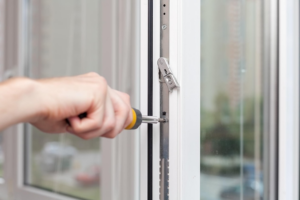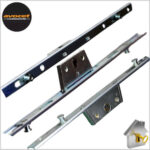5 Laws Anyone Working In Lock Repair Should Know
페이지 정보

본문
How to Do Your Own double glazed window lock repairs Repair
You can repair your locks yourself or engage a professional locksmith when they begin to fail. Repairing locks can be difficult, and the wrong approach could cause further damage.
 You should first check to find out if the issue is caused by dirt or dust. Graphite spray or silicone-based oil can be used to clear this problem.
You should first check to find out if the issue is caused by dirt or dust. Graphite spray or silicone-based oil can be used to clear this problem.
1. Locked Door Knob or Handle
Door knobs and handles may be loose in time, which can result in an unbalanced door handle or knobs that are difficult to open. Knobs that are loose in the door aren't just annoying but they can also compromise your building's security, making it crucial to resolve the issue as quickly as possible. Fortunately, a loose doorknob or handle is fairly simple to fix. Based on the type of lock you have installed on your door, there are several options to fix this. Certain lock systems come with easily accessible mounting screws, while others use backplates that hide the screws. If your door uses the one that is hidden, the process may be more complicated.
 The majority of doorknobs for interior use are designed to slip over a spindle that is cylindrical, which is attached to the door as a part of the latch assembly. If yours is jiggly, it could be due to a small screw, called a setscrew, on the inside of the doorknob, which is keeping it from sliding over the spindle. Make use of a flashlight to help you locate the set screw and use an Allen wrench to tighten it. After the screw has been tightened then turn the knob to verify if it feels secure.
The majority of doorknobs for interior use are designed to slip over a spindle that is cylindrical, which is attached to the door as a part of the latch assembly. If yours is jiggly, it could be due to a small screw, called a setscrew, on the inside of the doorknob, which is keeping it from sliding over the spindle. Make use of a flashlight to help you locate the set screw and use an Allen wrench to tighten it. After the screw has been tightened then turn the knob to verify if it feels secure.
If your knob still feels jiggly, it's possible that the set screw isn't positioned properly. To ensure that the screw is in the correct position Look for a small, matching button on the spindle. Slide the knob over the spindle after pressing the button with the flathead screwdriver. As you do this the knob should click into place, indicating that it is placed correctly on the spindle.
After you've made sure the set screw is positioned properly and tighten it once more to ensure that the knob or handle is in place. This should solve the issue, but if not then you might need to remove the knob and inspect the backplate for loose or missing screws. You'll need to replace the screws if this is the situation before you can install the knob or handle. If you aren't comfortable with this kind repair, you must seek out a professional locksmith who offers repair for damaged locks to assist.
2. The key won't spin in the lock.
There are a number of reasons that your key may stop turning inside the lock. One of the most common reasons is that the pins within the cylinder are beginning to wear out, which means they don't have the correct shape to move the sliders, wafers or tumblers that allow the key to open the lock. In this situation, spraying the lock with lubricant based on silicone or graphite spray will coat the pins to enable them to move.
However, if the issue is more severe and the key has bent out of shape, you may need to have it professionally straightened. A professional locksmith will employ a special tool that has an edge that is curved to fit into the groove that runs along the edge of the key. This kind of tool is not able to be found in hardware stores. However you can purchase an entire set of required tools online or from an experienced locksmith.
Another possibility is that the lock has become dirty or affected. Dust can build up over time within the lock's cylinder, and cause the springs or pins to become stuck. In this situation, you'll need to spray the lock with WD-40, graphite spray or a lubricant made of silicone to remove it and return the pins to their original position.
If the key itself has become damaged, it could be a cause for concern. Over time, repeated use can wear down the grooves of a key. This could result in the key not fitting properly into the cylinder, therefore it's crucial to pay attention and regularly check whether your key fits properly.
In the winter months locks can freeze, which can stop the pins and springs from moving when the key is placed. This can be a frustrating issue, but is usually easily solved by warming the lock up with hot water and changing the lubricant. However, if the lock is damaged or frozen beyond repair, it's likely to require replacement by an expert.
3. The Lock isn't Turning
If you've ever encountered an unresponsive lock and isn't able to be opened it can be incredibly frustrating. If it occurs frequently, you might consider getting locksmiths to come examine the lock and see if they can assist. Fortunately, this isn't always necessary as there are some things that can be easily repaired without the need for professional assistance.
The key will not turn inside the lock if damaged. This could happen if you've lost your keys or it is broken in the lock. Instead of trying to pull it out of the window lock repair which could cause the broken piece of the key to be pushed further inside the upvc window locking mechanism repair, which could make the problem much worse Try using pliers with needles to remove it from the lock. You should be cautious not to cut off any of the broken piece with the pliers or you may damage the lock.
It's also possible that the lock is misaligned, which can cause the door to not latch correctly. If you happen to have an extra key, it could be tested in the lock to ensure that it works correctly and isn't the cause of the problem. If you find that the lock is misaligned tightening the screws on the strike plate will fix the problem and allow the upvc Window lock repairs near me to perform normally.
Another reason your key may not be turning is because there is dust or dirt in the lock hindering it from turning. Using graphite sprays or a silicone-based lubricant can solve this problem by coating the pins within the lock, allowing them to move up and down in a normal manner. It's crucial not to use products that contain oil such as WD-40 to solve this issue, as these can cause further obstructions later on.
It's also worth noting that there are certain types of keys that aren't able to fit into all upvc windows locks repair. If this is the case, you'll need to have a new key made by a local hardware store.
4. The Cylinder Is Rotating
Hairpin vortices can form when a cylinder is rotated in a confinement space. These vortices may exert significant forces on the cylinder that is rotating. The forces are proportional to the dimensionless radius of curvature x and the confinement factor k. The simplified model presented here predicts the effect of these parameters on the force and torque on the cylinder that is confined. The head, tube and main body of the cylinder are constructed of aluminium alloy.
If you are able insert your key and turn it but the lock is still rotating the cylinder could be defective. Rekeying the lock can fix the issue. You can purchase kits for this purpose online or in most big box stores.
You can repair your locks yourself or engage a professional locksmith when they begin to fail. Repairing locks can be difficult, and the wrong approach could cause further damage.
 You should first check to find out if the issue is caused by dirt or dust. Graphite spray or silicone-based oil can be used to clear this problem.
You should first check to find out if the issue is caused by dirt or dust. Graphite spray or silicone-based oil can be used to clear this problem.1. Locked Door Knob or Handle
Door knobs and handles may be loose in time, which can result in an unbalanced door handle or knobs that are difficult to open. Knobs that are loose in the door aren't just annoying but they can also compromise your building's security, making it crucial to resolve the issue as quickly as possible. Fortunately, a loose doorknob or handle is fairly simple to fix. Based on the type of lock you have installed on your door, there are several options to fix this. Certain lock systems come with easily accessible mounting screws, while others use backplates that hide the screws. If your door uses the one that is hidden, the process may be more complicated.
 The majority of doorknobs for interior use are designed to slip over a spindle that is cylindrical, which is attached to the door as a part of the latch assembly. If yours is jiggly, it could be due to a small screw, called a setscrew, on the inside of the doorknob, which is keeping it from sliding over the spindle. Make use of a flashlight to help you locate the set screw and use an Allen wrench to tighten it. After the screw has been tightened then turn the knob to verify if it feels secure.
The majority of doorknobs for interior use are designed to slip over a spindle that is cylindrical, which is attached to the door as a part of the latch assembly. If yours is jiggly, it could be due to a small screw, called a setscrew, on the inside of the doorknob, which is keeping it from sliding over the spindle. Make use of a flashlight to help you locate the set screw and use an Allen wrench to tighten it. After the screw has been tightened then turn the knob to verify if it feels secure.If your knob still feels jiggly, it's possible that the set screw isn't positioned properly. To ensure that the screw is in the correct position Look for a small, matching button on the spindle. Slide the knob over the spindle after pressing the button with the flathead screwdriver. As you do this the knob should click into place, indicating that it is placed correctly on the spindle.
After you've made sure the set screw is positioned properly and tighten it once more to ensure that the knob or handle is in place. This should solve the issue, but if not then you might need to remove the knob and inspect the backplate for loose or missing screws. You'll need to replace the screws if this is the situation before you can install the knob or handle. If you aren't comfortable with this kind repair, you must seek out a professional locksmith who offers repair for damaged locks to assist.
2. The key won't spin in the lock.
There are a number of reasons that your key may stop turning inside the lock. One of the most common reasons is that the pins within the cylinder are beginning to wear out, which means they don't have the correct shape to move the sliders, wafers or tumblers that allow the key to open the lock. In this situation, spraying the lock with lubricant based on silicone or graphite spray will coat the pins to enable them to move.
However, if the issue is more severe and the key has bent out of shape, you may need to have it professionally straightened. A professional locksmith will employ a special tool that has an edge that is curved to fit into the groove that runs along the edge of the key. This kind of tool is not able to be found in hardware stores. However you can purchase an entire set of required tools online or from an experienced locksmith.
Another possibility is that the lock has become dirty or affected. Dust can build up over time within the lock's cylinder, and cause the springs or pins to become stuck. In this situation, you'll need to spray the lock with WD-40, graphite spray or a lubricant made of silicone to remove it and return the pins to their original position.
If the key itself has become damaged, it could be a cause for concern. Over time, repeated use can wear down the grooves of a key. This could result in the key not fitting properly into the cylinder, therefore it's crucial to pay attention and regularly check whether your key fits properly.
In the winter months locks can freeze, which can stop the pins and springs from moving when the key is placed. This can be a frustrating issue, but is usually easily solved by warming the lock up with hot water and changing the lubricant. However, if the lock is damaged or frozen beyond repair, it's likely to require replacement by an expert.
3. The Lock isn't Turning
If you've ever encountered an unresponsive lock and isn't able to be opened it can be incredibly frustrating. If it occurs frequently, you might consider getting locksmiths to come examine the lock and see if they can assist. Fortunately, this isn't always necessary as there are some things that can be easily repaired without the need for professional assistance.
The key will not turn inside the lock if damaged. This could happen if you've lost your keys or it is broken in the lock. Instead of trying to pull it out of the window lock repair which could cause the broken piece of the key to be pushed further inside the upvc window locking mechanism repair, which could make the problem much worse Try using pliers with needles to remove it from the lock. You should be cautious not to cut off any of the broken piece with the pliers or you may damage the lock.
It's also possible that the lock is misaligned, which can cause the door to not latch correctly. If you happen to have an extra key, it could be tested in the lock to ensure that it works correctly and isn't the cause of the problem. If you find that the lock is misaligned tightening the screws on the strike plate will fix the problem and allow the upvc Window lock repairs near me to perform normally.
Another reason your key may not be turning is because there is dust or dirt in the lock hindering it from turning. Using graphite sprays or a silicone-based lubricant can solve this problem by coating the pins within the lock, allowing them to move up and down in a normal manner. It's crucial not to use products that contain oil such as WD-40 to solve this issue, as these can cause further obstructions later on.
It's also worth noting that there are certain types of keys that aren't able to fit into all upvc windows locks repair. If this is the case, you'll need to have a new key made by a local hardware store.
4. The Cylinder Is Rotating
Hairpin vortices can form when a cylinder is rotated in a confinement space. These vortices may exert significant forces on the cylinder that is rotating. The forces are proportional to the dimensionless radius of curvature x and the confinement factor k. The simplified model presented here predicts the effect of these parameters on the force and torque on the cylinder that is confined. The head, tube and main body of the cylinder are constructed of aluminium alloy.
If you are able insert your key and turn it but the lock is still rotating the cylinder could be defective. Rekeying the lock can fix the issue. You can purchase kits for this purpose online or in most big box stores.
- 이전글10 Fridge Freezer That Are Unexpected 24.12.07
- 다음글The Address Collection Site Success Story You'll Never Believe 24.12.07
댓글목록
등록된 댓글이 없습니다.


 한국어
한국어  plastic surgery center
plastic surgery center





